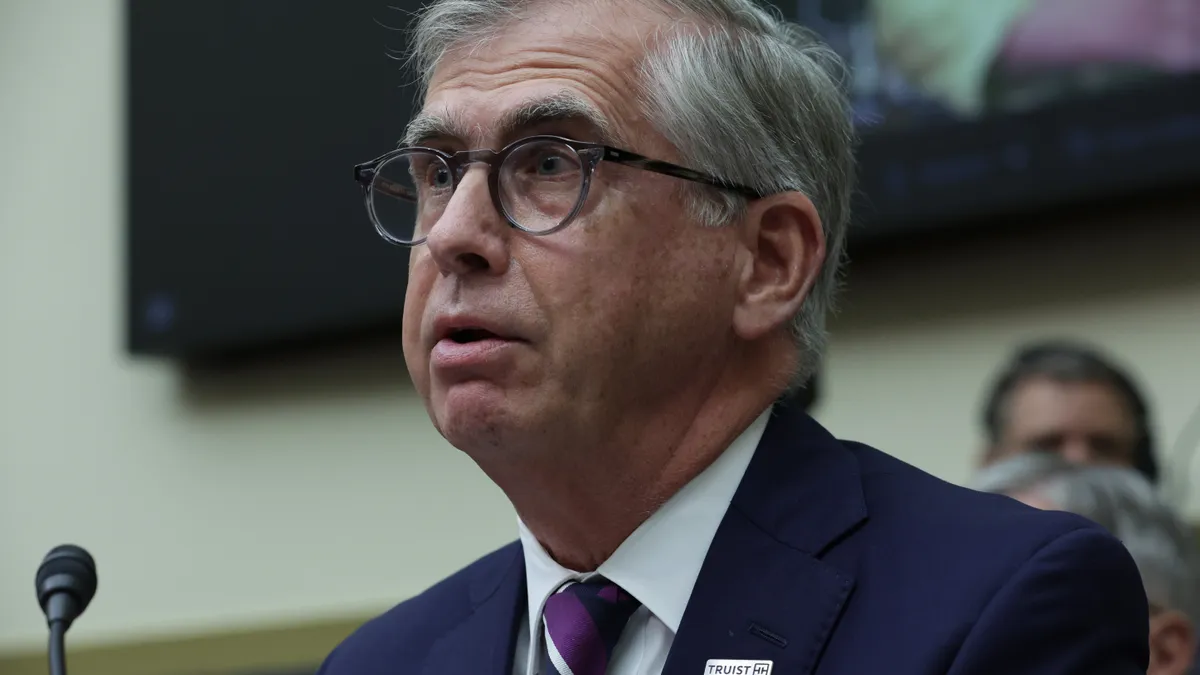Truist executives defended the bank’s spending approach Monday, promising to keep costs in check while also investing in certain areas of the business such as payments and middle market lending.
That pledge comes a week after the bank, which reported second-quarter earnings Monday, confirmed it’s cutting an undisclosed number of tech department jobs. Following a $750 million cost-cutting plan announced last September, the lender’s headcount continued its steady decline, coming in at 38,140 as of the end of June, down 3% from Q1 and 11% from the year-earlier quarter, according to earnings materials.
Charlotte, North Carolina-based Truist saw its second-quarter net income plummet 33%, to $826 million, heavily affected by $6.7 billion in securities losses tied to a balance sheet repositioning in the wake of the Truist Insurance Holdings sale, the bank said.
Of the bank’s $96 million in restructuring charges for the quarter, $33 million of that primarily related to severance and real estate rationalization, while the rest pertained to legal and other expenses linked with closing the divestiture of TIH, said CFO Mike Maguire.
The bank’s $3.09 billion in second-quarter non-interest expenses represented a 1% year-over-year increase and an 8% jump over the prior quarter. The bank is projecting its third-quarter expenses to grow 3% over the second quarter, and its revenue to rise 1-2%. Regarding expenses, Maguire also noted there “may be a touch of growth in the fourth [quarter] as well.”
Truist CEO Bill Rogers said the bank is “fully committed” to its goal of keeping expenses flat this year versus last year. Still, the bank recently “invested heavily” in its payments business and has made key leadership additions, “as this is an area where we see significant opportunity for growth over time, not only with new clients but also within our existing client base,” Rogers said.
Additionally, Truist has hired from larger banks to add to its wholesale team, he said.
“We plan to continue adding talent in wholesale with a specific focus on further building out our middle market and commercial lending segment, which represents one of the largest growth opportunities within our regional business,” Rogers said. In that endeavor, the bank aims to focus mainly on industries that support existing corporate investment banking coverage and expertise, he said.
Maguire said Truist has been “very focused” on cost discipline in the first half of the year, but as the company approached the mid-point of the year, the lender has come back to some delayed initiatives, including marketing spending or hiring in certain segments of the business. Those are some of the factors driving the second-half expense outlook, he told analysts.
Rogers defended the bank’s spending, noting that when Truist announced the cost-cutting plan last fall, “we were always really clear this was going to include investments,” Rogers added.
“We sort of know the next dollar to invest with a lot of confidence, and we also have just incredibly strong discipline around the expense side, where the opportunities are,” Rogers said. “The discipline that we have in the company around both of those is significantly increased.”
Rogers declined to give any expense guidance for 2025, but said the bank will maintain its focus on cost discipline, and expenses will be more “parallel” to revenue opportunities.
The CEO also noted “much of the profitability improvement potential we are working towards is centered on further deepening of existing client relationships, and verticals and product lines that already exist at Truist.”
It’s been nearly five years since SunTrust and BB&T merged to form Truist, creating a super-regional bank in the southeast. In a note to clients Monday, Piper Sandler analyst Scott Siefers said Truist “has pushed the ball further downfield in the past year more than we recall the story having moved forward in the past few years combined.”














